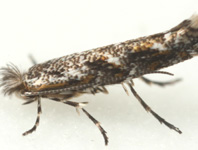Abstract
Haetosmia is a species-poor genus of osmiine bees (Megachilidae) containing six species, which inhabit deserts and semideserts from the Canary Islands to Central Asia. Formerly considered to be restricted to the southern Palaearctic region, the genus is shown here to occur also in the northern Afrotropical region. The females of all six Haetosmia species collect pollen from the narrow-tubed flowers of Heliotropium (Boraginaceae) with the aid of specialized pollen-harvesting bristles on the proboscis. Current knowledge suggests that Haetosmia species are restricted to sandy habitats, excavate their nests in the ground and use chewed leaves to construct their urn-shaped brood cells, which are placed side by side in an enlarged chamber at the end of the nesting burrow. The taxonomic revision of Haetosmia revealed the existence of two undescribed species, H. ethiopiensis spec. nov. from eastern Africa and H. pakistaniensis spec. nov. from Pakistan. Due to clear morphological gaps and overlapping distribution area with the nominotypical subspecies, H. brachyura altera (Peters 1974) is elevated to species rank. Keys for the identification of the six Haetosmia species are provided.
References
Coppock, D.L. (1994) The Borana Plateau of southern Ethiopia: synthesis of pastoral research, development and change, 1980–91. International Lifestock Centre for Africa, Addis Abeba, Ethiopia, 393 pp.
Demissev, S. & Nordal, I. (2010) Aloes and Lilies of Ethiopia and Eritrea. Shama Books, Addis Ababa, 351 pp.
Evenari, M, Shanan, L. & Tadmor, N. (1982) The Negev, the Challenge of a Desert. Harvard University Press, Cambridge, 437 pp.
https://doi.org/10.4159/harvard.9780674419254Feinbrun-Dothan, N. (1978) Flora Palaestina. Part 3. Ericaceae to Compositae. Israel Academy of Sciences and Humanities, Jerusalem, 481 pp.
Friis, I., Demissew, S. & van Breugel, P. (2010) Atlas of the potential vegetation of Ethiopia. Biologiske Skrifter, 58, 1–306.
Ghazanfar, S.A. (2015) Flora of the Sultanate of Oman. Volume 3, Loganiaceae to Asteraceae. Scripta Botanica Belgica, 55, 1–386.
Gonzalez, V.H. & Griswold, T.L. (2013) Wool carder bees of the genus Anthidium in the Western Hemisphere (Hymenoptera: Megachilidae, Anthidiini): diversity, host plant associations, phylogeny, and biogeography. Zoological Journal of the Linnaean Society, 168, 221–425.
https://doi.org/10.1111/zoj.12017Gotlieb, A., Pisanty, G., Rozen, J.G., Müller, A., Röder, G., Sedivy, C. & Praz, C. (2014) Nests, floral preferences, and immatures of the bee Haetosmia vechti (Hymenoptera: Megachilidae: Osmiini). American Museum Novitates, 3808, 1–20.
https://doi.org/10.1206/3808.1Hicks, C.H. (1928) Notes on Anthidium palliventre Cresson. The Pan-Pacific Entomologist, 5, 51–52.
Hohmann, H., La Roche, F., Ortega, G. & Barquin, J. (1993) Bienen, Wespen und Ameisen der Kanarischen Inseln. Veröffentlichungen aus dem Übersee-Museum Bremen, 12, 1–465 & 493–712.
Mavromoustakis, G.A. (1954) New and interesting bees (Hymenoptera, Apoidea) from Israel. Bulletin of the Research Council of Israel, 4, 256–275.
Michener, C.D. (2007) The bees of the world. 2nd Edition. Johns Hopkins University Press, Baltimore and London, 953 pp.
Morawitz, F. (1875) Bees (Mellifera) I. Apidae genuinae. In: Travel to Turkestan by A. P. Fedtschenko. Moscow, 160 pp.
Peters, D.S. (1974) Über die Untergattung Haetosmia Popov, 1952 (Insecta: Hymenoptera: Megachilidae: Osmia). Senckenbergiana Biologica, 55, 293–309.
Peters, D.S. (1983) Einige von H. Priesner am Gebel Elba gesammelte Megachilidae sowie eine neue Art der Gattung Heriades aus Südafrika (Hymenoptera: Apoidea). Linzer Biologische Beiträge, 14, 95–109.
Popov, V.B. (1952) Bee fauna (Hymenoptera, Apoidea) of south-western Turkmenia and its landscape distribution. Trudy Zoologicheskogo Instituta Akademii Nauk SSSR, 10, 61–117.
Popov, V.B. (1960) New and little-known species of bees (Hymenoptera, Apoidea) from Turkmenia. Trudy Zoologiceskzo Instituta Akademija Nauk SSSR, 27, 247–263.
Praz, C.J., Müller, A., Danforth, B.N., Griswold, T.L., Widmer, A. & Dorn, S. (2008) Phylogeny and biogeography of bees of the tribe Osmiini (Hymenoptera: Megachilidae). Molecular Phylogenetics and Evolution, 49, 185–197.
https://doi.org/10.1016/j.ympev.2008.07.005Sedivy, C., Dorn, S. & Müller, A. (2013) Molecular phylogeny of the bee genus Hoplitis (Megachilidae: Osmiini) - how does nesting biology affect biogeography? Zoological Journal of the Linnean Society, 167, 28–42.
https://doi.org/10.1111/j.1096-3642.2012.00876.xZanden, G. van der (1989) Neue oder wenig bekannte Arten und Unterarten der palaearktischen Megachiliden (Insecta, Hymenoptera, Apoidea: Megachilidae). Reichenbachia, 53, 71–86.
Zanden, G. van der (1994) Neue Arten und Unterarten, eine neue Untergattung und einige neue Fälle von Synonymie der paläarktischen Bauchsammler (Insecta: Hymenoptera: Apoidea: Megachilidae). Reichenbachia, 30, 167–172.

